The socio-economic benefits of tidal power to the European economy
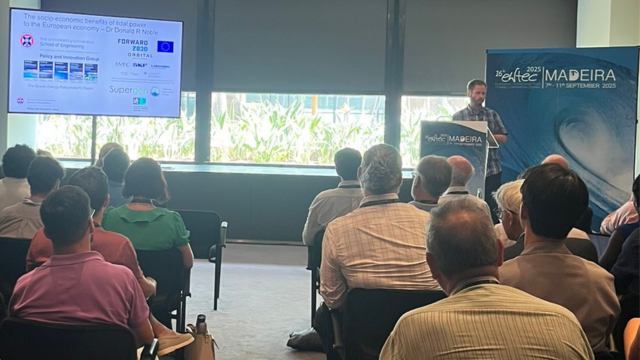
A new paper has been published by researchers from The University of Edinburgh exploring the socio-economic benefits of tidal power to the European economy.
The study was conducted as part of the FORWARD2030 project, funded by the European Union’s Horizon 2020 research and innovation programme.
Lead author, Dr Donald R. Noble, Research Associate at the University of Edinburgh, recently presented the study at the 16th European Wave and Tidal Energy Conference (EWTEC) in Maderia (pictured above) and provides some key insights below.
This work aims to quantify the wider socio-economic benefits to the European economy arising from building and operating tidal power projects. It considers both the broad-scale with a regional analysis from now until 2050, and offers project-level context from a near-term Orkney case study.
Europe is at the forefront of developing and deploying tidal stream technology, with a significant pipeline of projects to be built over the coming years, mostly in the UK and France, but with a supply chain spanning across Europe. Tidal stream power offers a predictable source of renewable energy, contributing to energy security and net zero targets.
For this study, the socio-economic benefits resulting from developing, building and operating tidal stream projects were modelled and quantified using the common metrics of gross value added (GVA) and full-time equivalent (FTE) jobs and cumulative job-years of employment. As the future is uncertain, credible assumptions were made around the deployment of tidal technology in different markets, the expected cost-reduction trajectory and typical breakdown of project costs, as well as the local content within the supply chain for these projects.
With a similar growth rate to wind power, there is the potential for 20 to 40 GW of tidal stream turbines to be connected to the European electricity grid by 2050. Similarly, there could be an export market of 60 to 80 GW over this same period. While costs for tidal projects are currently higher than many other renewables, these are expected to reduce as more projects are built. An ambitious but achievable “learning rate” of almost 15% has been used, consistent with what has been observed in other comparable technologies in recent decades.
Results at a European level
The total GVA from developing, building and operating tidal stream farms in Europe from now until 2050 could be between €15bn and €46.5bn depending on deployment and supply chain ambition. This is shown in Figure 1. The international export market could add a further €2bn to €26bn in GVA to the European economy. The benefits in striving for a higher ambition in supply chain retention are clear given they are more than double the lower ambition scenario regardless of the deployment assumptions.
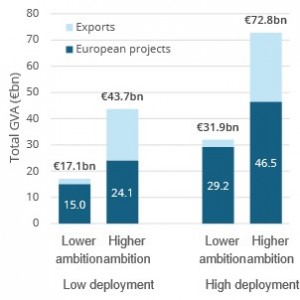
Figure 1 | Total GVA for European projects and international exports by scenario of deployment at supply chain ambition.
It is important to remember that it is people working in the industry that generate the GVA, therefore the results in Figure 2 regarding total employment look similar to Figure 1.
In the high deployment higher supply chain ambition scenario on the right, by 2050 there could be almost 70,000 FTE jobs from tidal stream projects in Europe, plus an additional 40,000 FTE jobs supported by exports.
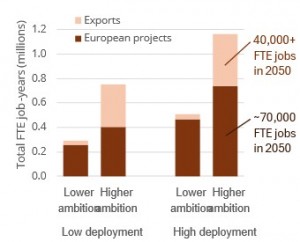
Figure 2 | Total FTE job-years for European projects and international exports by scenario of deployment and supply chain ambition.
The breakdown of jobs by project cost centre is shown in Figure 3. By far the largest share, almost half, comes from manufacturing the generating device. Ongoing operation and maintenance (O&M) over the lifetime is the next largest share, growing to over 24% of all FTE jobs in the year 2050, as there are more devices installed.
The other project cost-centres modelled are the supply of the balance of plant such as cables and moorings, the development and project management, plus the installation and commissioning. Decommissioning is not shown, as given the 25-year project lifetime assumptions this is very limited by 2050.
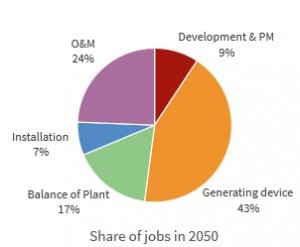
Figure 3 | Share of FTE jobs in 2050 by main project cost centres.
Project level context – Orkney case study
To illustrate the potential economic benefits of a small project built over the near-term, results are presented for an Orkney project case study. This is a hypothetical 30 MW project in Orkney, Scotland with 12 Orbital O2-X turbines built and installed between 2026 and 2030. The supply chain is assumed to be 100% European, geographically split into the Orkney Islands, the rest of Scotland, rest of the UK, and the rest of Europe following expectations for the upcoming turbine construction.
As shown in Figure 4, this near-term project could generate around £100m (€118m) in GVA to Scotland, with additional value in the rest of the UK and Europe. The build phase (construction and installation) could provide over 1,000 job-years of employment, equivalent to around 170 FTE jobs located across Europe. Ongoing O&M is a further 300 job-years employment, or around 13 FTE jobs over the 25-year lifetime; these would mostly be located in Orkney and Scotland, near to the project site.
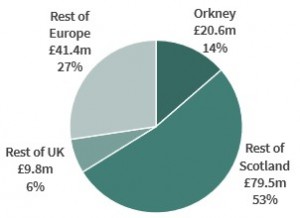 |
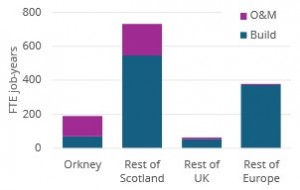 |
| Figure 4 | Share of Orkney project GVA by spend location. | Figure 5 | Cumulative Orkney project job-years by spend location and project stage. |
Conclusions
There are considerable potential economic benefits from building tidal stream projects in Europe from now until 2050. This could amount to €73 bn in gross value added (GVA) from European projects and technology exports. Tidal stream projects are also a source of high-value jobs in Europe, potentially growing to over 110,000 FTE jobs in 2050. These are predominantly in building the devices and in ongoing operations and maintenance. The jobs and value added demonstrated in this analysis are at a European, national, and local level.
More details and results can be found in the paper published as part of the proceedings of the 16th EWTEC, 8 Sept 2025. It is available open-access via the University of Edinburgh Research Explorer. See: Research paper: The socio-economic benefits of tidal power to the European economy, Proc. EWTEC, vol. 16, Sep. 2025





